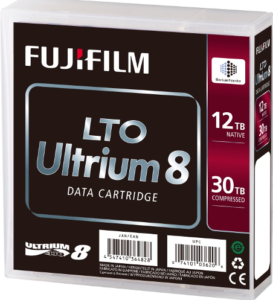By Rich Gadomski
March 19, 2020

As LTO-8 drives and media are increasingly deployed and widely available, the value proposition of LTO-8 is being confirmed by customers and it’s a pretty impressive story.
In the case of a major high-performance computing (HPC) customer who had been using LTO-6 previously for their archive, the jump to LTO-8 has done wonders for their available capacity. With approximately 7,000 slots in their library, fully loaded with LTO-6 media at 2.5TB each yielded a total native storage capacity of 17.5 PB. Migrating to LTO-8 drives and eventually converting those slots to LTO-8 media at 12.0 TB gives them up to a massive 84 PBs, almost a 5X increase. That’s lots of room to scale as needed!
Performance also gets a big boost as LTO-6 drives are rated at 160 MB per second transfer rate compared to LTO-8 drives at 360 MB per second. This means fewer drives are required to meet the same performance objectives. As a result, TCO also gets a major boost as fewer drives, fewer pieces of media and no additional floor space or library frames are required to manage the same amount of data.
Reliability is another value prop of today’s modern tape and it has been confirmed by several recent examples of migration projects done by some very high profile HPCs. In a migration, data is being recovered from legacy tapes and then rewritten to the latest generation of tape. What we are hearing after the check-sum verification process is that there have been few or no read errors or data loss in the migration process. As Vladimir Bahyl of CERN stated at a recent end-user meeting after having gone through a 100 PB migration, “Tape’s reliability is excellent.” A migration is a good time to discover that you can read back all your data rather than confirming this detail during an actual data recovery!
We expected that the launch of LTO-8 would give new energy to the business case for modern data storage tape – a case that has always included air-gap security against cybercrime, low energy use, reliability, and scalability when compared to other media. As word spreads from end-users’ firsthand experiences with LTO-8, that business case seems stronger every day. And with even greater increases planned for LTO-9 and beyond, who can’t be optimistic about the future of tape?
